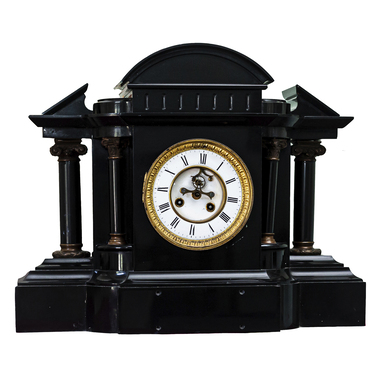The manufacturing facilities of many famous Russian clockmaking companies, for example, “P. Buhre”, “G. Moser”, “V. Gabus” — were located in the Swiss city of Le Locle. In some Russian cities, the companies owned a network of stores, warehouses, and workshops, where they received the imported parts and assembled the finished products. Russian artisans made the clock cases locally. This system was established as the duty on imports from abroad of the finished clocks was much higher than that on the parts, which were classified as metal at customs. Some German factories also operated under the same scheme.
In the second half of the 19th century, the clocks with mechanisms made by German companies, such as “Gustav Becker”, were the most popular. This company produced wall-mounted, mantel, table, and floor clocks. “Junghans”, another distinguished company, made alarm clocks, wall clocks, and wrist watches, while the “Lenzkirch” company specialized in mantel and tabletop clocks.
The German company “Lenzkirch” produced the mechanism for the mantel clock, presented in the exhibition. Masters Ignaz Schopperle and Eduard Hauser founded the factory in Lenzkirch on August 31, 1851. Hauser held the position of technical director. He not only designed the clockworks but also created machines for clockmaking.
Originally, the “Lenzkirch” company received raw mechanisms for its clocks from France. However, strained political relations between the countries complicated imports, and the company was forced to develop its own factories. Since 1867, “Lenzkirch” began to produce table clocks, small regulators, and travel alarm clocks with accurate movements of its own making, based on the French model. Experts believe it was the first German company that produced spring-driven clocks and sold them around the entire Black Forest, a region in southwestern Germany. Fifteen awards granted at national and international exhibitions confirm the high-quality standard of this company’s products. The millionth “Lenzkirch” clock was produced in February 1894.
In March 1899, Eduard Hauser left the company, and in August 1929, it was closed due to economic difficulties and was taken over by a competitor, the “Junghans AG” company.
In the second half of the 19th century, the clocks with mechanisms made by German companies, such as “Gustav Becker”, were the most popular. This company produced wall-mounted, mantel, table, and floor clocks. “Junghans”, another distinguished company, made alarm clocks, wall clocks, and wrist watches, while the “Lenzkirch” company specialized in mantel and tabletop clocks.
The German company “Lenzkirch” produced the mechanism for the mantel clock, presented in the exhibition. Masters Ignaz Schopperle and Eduard Hauser founded the factory in Lenzkirch on August 31, 1851. Hauser held the position of technical director. He not only designed the clockworks but also created machines for clockmaking.
Originally, the “Lenzkirch” company received raw mechanisms for its clocks from France. However, strained political relations between the countries complicated imports, and the company was forced to develop its own factories. Since 1867, “Lenzkirch” began to produce table clocks, small regulators, and travel alarm clocks with accurate movements of its own making, based on the French model. Experts believe it was the first German company that produced spring-driven clocks and sold them around the entire Black Forest, a region in southwestern Germany. Fifteen awards granted at national and international exhibitions confirm the high-quality standard of this company’s products. The millionth “Lenzkirch” clock was produced in February 1894.
In March 1899, Eduard Hauser left the company, and in August 1929, it was closed due to economic difficulties and was taken over by a competitor, the “Junghans AG” company.



